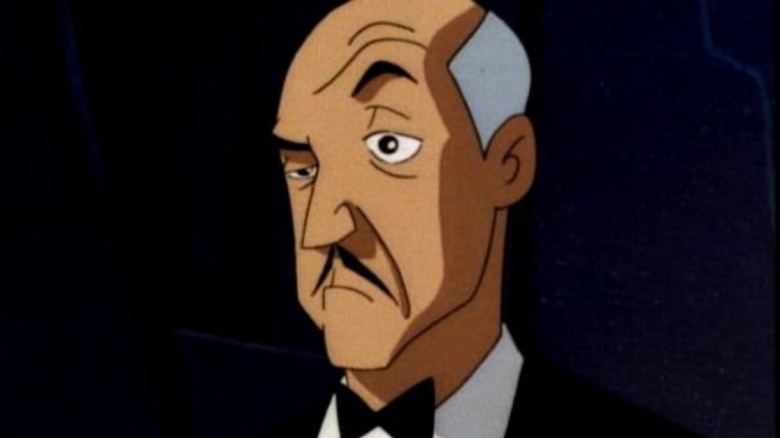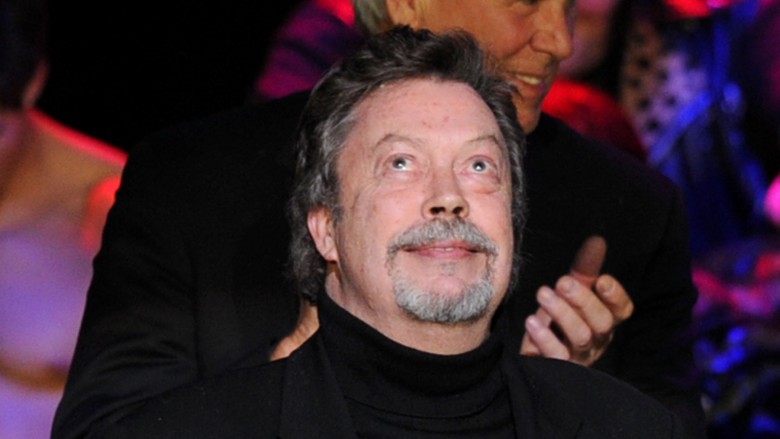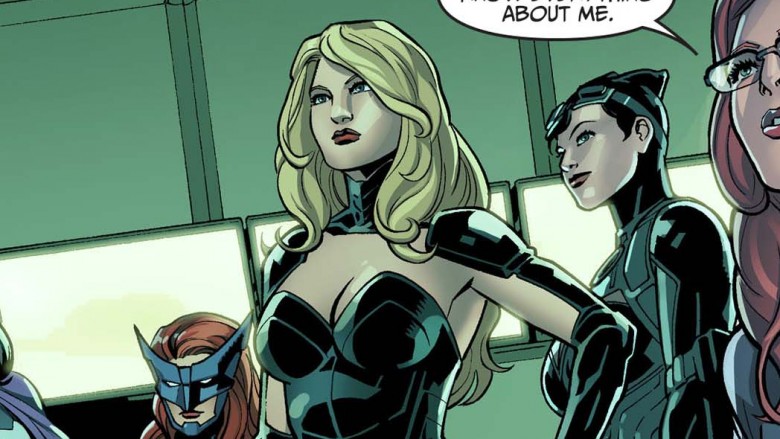The Untold Truth Of Batman: The Animated Series
Launched in 1992, Batman: The Animated Series is still revered as one of the greatest cartoons ever conceived. It pushed the boundaries of what you could do with the animated medium, and its timeless design holds up as well today as it did 25 years ago.
But this beloved version of the Dark Knight didn't come about easily—and the story behind the scenes is arguably just as entertaining as the episodes that eventually made it to the screen. Here's everything you might not know about a show you almost certainly still love.
They had to change an episode where Alfred was pooped on
Though it dealt with more than a few adult themes over the years, this was still an animated series—which means the creators were constantly battling it out with the censors over what they could and couldn't include onscreen. One of the most hilariously weird notes they got back from the network? They couldn't have a bat poop on Alfred. Executive Avery Coburn reportedly requested the change in an episode that originally featured a bat dropping some guano on Alfred's jacket. You can have Batman beat a bad guy to a pulp, but drop a bit of bat poop on a shirt? Apparently that's where they draw the line.
Days of Our Lives inspired Harley Quinn
She's gone on to become one of the most popular DC Comics characters in modern history, and you probably already know that Harley Quinn got her start on Batman: The Animated Series in a bit role. But did you know she was inspired by the long-running daytime drama Days of Our Lives?
Actress Arlene Sorkin was a childhood friend of Batman: The Animated Series co-creator Paul Dini, and Dini actually got the idea for Harley when he saw Sorkin perform as a clown in a dream sequence on the show. They initially considered having the Joker dress as a woman for a gag, but felt it made more sense to introduce a female sidekick. So Harley Quinn was born—and they even invited Sorkin in to voice the character. Harley turned out to be a hit, and she became a key player in the series before making the jump to comics canon as a major character in the Batman universe.
Kevin Conroy was the first to use a different voice for Batman and Bruce Wayne
As much or more than any actor, Kevin Conroy is one of the first guys people think of when they think of the Dark Knight. Conroy was hired to voice Bruce Wayne and Batman for the animated series, and has reprised that role numerous times in the decades since. He's played Batman in movies like The Killing Joke, video games like the Arkham series, and old Bruce Wayne in Batman Beyond. If you don't hear Christian Bale's voice, you almost certainly think of Conroy's growl when you close your eyes and think of Batman. To that end, Conroy has taken his role extremely seriously: he was the first voice actor to use a different voice when playing both Batman and Bruce Wayne, and helped start a trend that persists to this day.
One episode was basically all about sex, but they snuck it past the censors
It's not uncommon for kids shows to sneak in a few jokes for adults, but looking back at the episode "The Ultimate Thrill," it's amazing they actually managed to sneak this one by the sensors. Let's set the scene: The pulpy villain Roxy Rocket cruises around on a giant, phallic-shaped rocket—often cooing about just how excited she gets about all this danger. But, umm, that's not all. She drops a boatload of sexual innuendos, and is especially impressed with Batman's staying power. As Batman saves her, she squeals "Oh baby!" It's really hard to understand how the censors didn't pick up on what Roxy was selling here. Watch this episode as an adult, and you'll be amazed by what you (and apparently the network) missed all those years ago.
The look was inspired by Space Ghost and 1940s Superman cartoons
When the animation team started mapping out their character designs, they didn't look at what had worked in the 1980s and early 1990s. They went a bit further back. Bruce Time and Paul Dini turned to the classic Space Ghost series and the 1940s Superman cartoons when figuring out how to sketch this version of Batman in a way that would stand the test of time and not look silly a few years later—and it worked.
It kickstarted a shared universe long before the DCEU
As DC continues to work out the kinks in its big-screen shared universe, the company should just take a peek at what worked a few years ago on the animated side. After the success of Batman, an entire world of animated shows was organically launched—with ample crossovers to keep fans tuning in. After Batman, the studio launched an animated Superman show, a retooled Batman series, Batman Beyond, Static Shock, the short-lived Zeta Project, Justice League, and Justice League Unlimited. All were set within the same universe, which spanned decades thanks to Batman Beyond. It made for some fantastic episodes and huge DC events—and it all started with Batman: The Animated Series.
It was heavily influenced by Tim Burton's Batman film
Tim Burton's hit Batman movies boosted the character's mainstream profile just before Batman: The Animated Series debuted, so naturally, the showrunners borrowed a few ingredients. The animators tried to mimic Burton's unique style, mixing modern tech with the retro visuals that made his films so original. The studio even tasked the team with basing the small-screen Penguin on Danny Devito's live-action take on the character, with the animators sketching from DeVito's on-set look to nail the style.
Bruce Timm and Paul Dini pitched it with a 2-minute pilot, which became the intro
Timm and Dini put together what essentially added up to a pitch reel to help sell the series to the network, which consisted of roughly two minutes of Batman swinging around the city and kicking butt. It was a bit amateurish, and the two animators actually voiced the entire thing themselves, but it was enough to show the network they definitely had the chops to pull it off. That pilot didn't go to waste once the series was picked up; it was retooled to create the intro sequence, and the original version finally saw official release on a DVD set several years ago. Check it out above.
The Joker was supposed to be voiced by Tim Curry, not Mark Hamill
It's hard to imagine anyone other than Mark Hamill bringing the animated Joker to life, but Tim Curry almost took the role of the Clown Prince of Crime. Curry actually did a bit of recording, but the creative team realized he just wasn't crazy and scary enough for what they wanted to do with the Joker. They eventually landed on Hamill, and the rest is history. Hamill has gone on to voice the Joker in a boatload of additional projects, from video games to animated films. It's a role that's almost as beloved as his other gig. You know, Star-something?
Fox killed a proposed Black Canary and Catwoman team-up episode
Since the series was animated and aimed at kiddie eyeballs, the network eventually issued a mandate that every episode had to feature Robin in a prominent or semi-prominent role. Which is kind of lame—and actually led the creative team to kill some interesting stories. One of them would have focused on Black Canary and Catwoman teaming up, but they just couldn't find a way to organically work the Boy Wonder into the mix, so the studio axed the idea altogether. The world will never know how that episode might have turned out.
Adam West played the meta-hero the Gray Ghost
One of the most acclaimed episodes of the animated series revolved around the fictional television series The Gray Ghost, which Bruce loved as a child. The actor who played the Ghost was eventually typecast because of his superhero gig all those years ago, so they turned to someone who could definitely relate to that challenge to bring him to life: Former Batman star Adam West. West did an amazing job with the character, and the episode was a clever way to pay homage to his Bat-legacy and create a memorable new character and piece of Bruce Wayne's backstory.
Not surprisingly, the Ghost has endured since his animated intro. The character, loosely based on the Shadow (which also inspired Batman himself), has popped up a few times in comics such as Batman: The Gotham Adventures and Gotham Academy. Movie posters for the Gray Ghost have also shown up in projects like Batman Beyond and Batman: Arkham Knight.
The show led to a creative revival for Mr. Freeze
Before this series, Mr. Freeze was basically just a cheesy bad guy who pursued a life of crime with ice. But the creative team saw potential for something more, and completely rewrote his origin story to give it a more tragic bent. This new Freeze was out to save his wife, and get revenge against those who wronged him. It was compelling stuff, and coupled with the stellar design work for his animated costume, Mr. Freeze enjoyed a renaissance. DC liked the backstory so much they incorporated it into the comic canon, making for some fantastic stories revolving around the multifaceted baddie.



